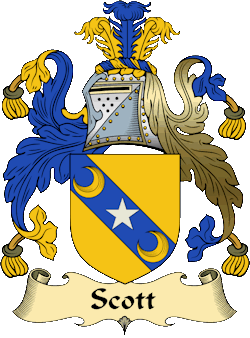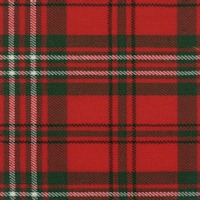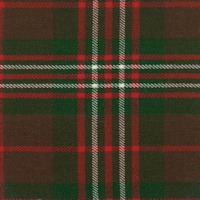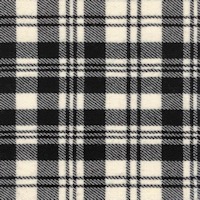Scott

Purchase Heraldry Products
Download Now!

Surname: Scott
Branch: Scott
Origins: Scottish
More Info: Scotland
|
|
Background: The Latin word Scotti was originally used to describe the Celts of Ireland. However the historian George Fraser Black notes in his Surnames of Scotland that the earliest certain record of the name was that of Uchtred 'Filius Scott', in a charter from around 1120, who bears a remarkably Saxon personal name if the family were truly of Celtic origin. In 1195 Henricus le Scotte witnessed a charter by David, Earl of Strathearn. At the beginning of the thirteenth century a Master Isaac Scotus witnessed charters by the Bishop of St Andrews. Michael Scott "the wizard" (1175 – c.1232) was a real-life scholar and philosopher, whom Walter Scott described in The Lay of the Last Minstrel as "addicted to the abstruse studies of judicial astrology, alchemy, physiognomy, and chiromancy. Hence he passed among his contemporaries for a skilful magician". Four generations after Uchtred, Sir Richard Scott married the heiress of Murthockstone and in doing so acquired her estates. Sir Richard was appointed as the ranger of Ettrick Forest and this brought to him the additional lands of Rankilburn. The new laird built his residence at Buccleuch and the estates were generally known by this name.
|
 Motto: Motto: Amo, I Love. Arms: Or, on a bend az. a star, betw. two crescents, ar. Crest: A stag trippant Proper, attired and unguled Or. Supporters: Two female figures Proper, habited from the waist downwards in kirtles Azure gathered up at the knees, the arms and bosoms uncovered, around the shoulders flowing mantles as before suspended by the exterior hand, girdles and sandals Gules, and their heads adorned with a plume of three ostrich feathers Argent. Plant: Blaeberry. View the Heraldry Dictionary for help.

The Latin word 'Scotti' originally denoted the Irish Celts, and later the Gaels in general. However, Black, in
his Surnames of Scotland, notes that in the earliest certain records of the name (in a charter around 1120)
Uchtred 'Filius Scott' bears a remarkably Saxon personal name, if the family were truly of Celtic origin.
Henricus le Scotte witnessed a charter by David, Earl of Strathearn, around 1195. A master Isaac Scotus witnessed
charters by the bishop of St. Andrews at the beginning of the 13th century.
Four generations after Uchtred, Sir Richard Scott married the daughter and heiress of Murthochstone, and thereby
acquired her estates. Sir Richard was appointed ranger of Ettrick Forest, which brought the additional lands of
Rankilburn into the family demesne. The new laird built his residence at Buccleuch, and the estates generally
became known by this name. His son, Michael, second Laird of Buccleuch, proved a staunch supporter of Robert the
Bruce, and distinguished himself at the Battle of Halidon Hill in 1333. He was one of the few that escaped the
carnage of that disastrous day, but he later fell at Durham in 1346. He left two sons: Robert, the third Laird;
and john, who founded the important cadet house of Synton, from whom the Lords of Polwarth were to descend.
Robert died around 1389, probably from wounds received at the Battle of Otterburn. Robert, fifth of Buccleuch,
succeeded to the family estates when his father, Sir Walter, was killed in battle in 1402. He consolidated the
family's estates, acquiring in 1420 half the lands of Branxholm. The sixth Laird exchanged Murthockstone for the
remainder of Branxholm. The sixth Laird exchanged Murthockstone for the remainder of Branxholm. He was active in
the struggle of the Crown to suppress the powerful Douglas faction, and received tracts of Dougland land when the
King's cuse prevailed. Branxholm became a free barony in 1463, held on the annual payments to the Crown of a red
rose on the feast day of St. John the Baptist.
By the end of the fifteenth century, the Scotts were amoung the most powerful of the Borders clans, and the chief
could easily call upon a thousand spears to enforce his weill. In common with most Borders families, the Scotts
quarrelled with their neighbors, and in particular with the Kerrs of Cessford. The feud flared up when Sir Walter
Scott of Buccleuch tried to free the young James V, then being held by the Earl of Angus at Darnick just west of
Melrose. On 24 July 1526 he launched his attack, and in the ensuing fray Kerr of Cessford was killed. Sir Walter
himself was also wounded. Buccleuch fought at the Battle of Pinkie in 1547, and four years later was appointed
warden of Liddesdale and the middle marches. The Kerrs, however, only biding their time, and they set upon Sir
Walter in the High Street of Edinburgh on 4 October 1552 and killed him. The feud was brought to an end when Sir
Thomas Kerr of Ferniehirst married Janet Scott, sister of the tenth Laird of Buccleuch. The tenth Laird was a
keen supporter of Marcy, Queen of Scots,, until his death in 1574. His son, another Walter Scott, succeeded to
the estates as a youth. He went on to become a daring military leader, being known to his admirers as the Bold
Buccleuch, a man much in the mould of his vigorous ancestors. He rescued his vassal, William Armstrong, known as
Kinmont Willy, from the previously impregnable fortress of Carlisle in 1596.
James VI's accession to the English throne was follwed by a royal policy to pacify the Borders, and so Lord Scott
sought military adventure on the Continent fighting for the Prince of Orange in the Netherlands. His son, Walter,
also commanded a regiment for the States of Holland against the Spanish, and was advanced to the title of Earl of
Buccleuch in 1619. The second Earl, Francis, supported the National Covenant and opposed the religious policies
of Charles I. He led his horsemen against Montrose, at Philiphaugh, a defeat which marked the turning point in
the king's was in Scotland. He died in 1651 at the early age of twenty-five, and was succeeded by his four-year-
old daughter, Mary, Countess of Buccleuch. She was married at the age of eleven to Walter Scott of Highschester
by special sanction of the General Assembly of the Church of Scotland, but died in March 1661, aged only fourteen
years. She was succeeded by her sister, Anne, who was considered on of the greatest heiresses in the kingdom and
consequently worthy of a splendid marriage. Charles II sought her hand for his illegitimate son, James, Duke of
Monmouth, and when the married was agreed Monmouth assumed the name of Scott. On the day of the marriage in April
1663, the couple were also created Duke and Duchess of Buccleuch, with numerous subsidiary honours. Monmouth
later rose in rebellion against the Crown, and was executed in July 1685. His titles were forfeit, but as Anne
Scott had been specifically created Duchess of Buccleuch, her title was unaffected. The duchess was succeeded by
his grandson, Francis, second Duke of Buccleuch. The Buccleuch art collection, maintained in the Family's three
great houses of Drumlanrig, Bowhill and Boughton, is internationally renowned.
Name Variations: Scott, Scotti, Buccleuch, Geddes, Laidlaw, Langlangs.
References:One or more of the following publications has been referenced for this article.The General Armory; Sir Bernard Burke - 1842.
A Handbook of Mottoes; C.N. Elvin - 1860.
Scottish Clans and Tartans; Neil Grant - 2000.
Scottish Clan and Family Encyclopedia; George Way of Plean and Romilly Squire - 1994.
Scottish Clans and Tartans; Ian Grimble - 1973.
World Tartans; Iain Zaczek - 2001.
Clans and Families of Scotland; Alexander Fulton - 1991.

|
|

The beautiful heraldry artwork for this family is available to purchase on select products from the Celtic Radio Store. We look forward to filling your order!

|
|

|

Modern | 
Weathered | 
Whited Modern |
|
|
|